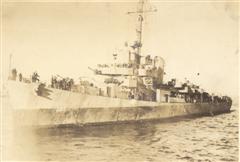USS Richey (DE-385)

| |
| Career (US) | |
|---|---|
| Namesake: | Joseph Lee Richey |
| Builder: | Brown Shipbuilding, Houston, Texas |
| Laid down: | 19 April 1943 |
| Launched: | 30 June 1943 |
| Commissioned: | 30 October 1943 |
| Decommissioned: | January 1947 |
| Struck: | 30 June 1968 |
| Fate: | Sunk as target off California, July 1969 |
| General characteristics | |
| Class and type: | Edsall-class destroyer escort |
| Displacement: |
1,253 tons standard 1,590 tons full load |
| Length: | 306 feet (93.27 m) |
| Beam: | 36.58 feet (11.15 m) |
| Draft: | 10.42 full load feet (3.18 m) |
| Propulsion: |
4 FM diesel engines, 4 diesel-generators, 6,000 shp (4.5 MW), 2 screws |
| Speed: | 21 knots (39 km/h) |
| Range: |
9,100 nmi. at 12 knots (17,000 km at 22 km/h) |
| Complement: | 8 officers, 201 enlisted |
| Armament: |
|
USS Richey (DE-385) was an Edsall-class destroyer escort built for the U.S. Navy during World War II. She served in the Atlantic Ocean and the Pacific Ocean and provided destroyer escort protection against submarine and air attack for Navy vessels and convoys.
She was named in honor of ensign Joseph Lee Richey who was killed 7 December 1941 during the Japanese attack on Pearl Harbor. She was laid down 19 April 1943 by Brown Shipbuilding Co., Houston, Texas; launched 30 June 1943; sponsored by Mrs. Joseph Lee Richey; and commissioned 30 October 1943, Comdr. Petros D. Miller, USCG, in command.
Contents
[hide]World War II North Atlantic operations
Following shakedown off Bermuda USS Richey (DE-485) commenced convoy escort duty in the Atlantic. From January to July 1944, she escorted convoys from New York and Norfolk, Virginia, to Casablanca, Morocco; Oran, Algeria; and Bizerte, Tunisia. From September to October, she guarded convoys from New York to Belfast and Londonderry, Northern Ireland. From January 1945 to late May she escorted convoys between the United States, France, and Great Britain. That April, Richey rescued 32 men from two tankers that had collided and caught fire, SS Nasbulk and SS St. Mihiel.
Transferred to the North Pacific Theatre
Following arrival in New York in May and overhaul, she proceeded via Cuba and the Panama Canal to the Pacific where she reported in July to the North Pacific Fleet at Adak, Alaska. In September she occupied the Japanese naval base at Ominato, northern Honshū, Japan. After a return to Adak, she sailed via Okinawa to Taku, to assist the occupation forces.
Post-War decommissioning
In March 1950 she entered the Atlantic Reserve Fleet. Loaned to the U.S. Coast Guard 1 April 1952, she was subsequently returned and entered the Pacific Reserve Fleet in June 1954, where she remained until struck from the Navy list 30 June 1968, and sunk as a target.
See also
References
- This article includes text from the public domain Dictionary of American Naval Fighting Ships. The entry can be found here.
External links
- Articles incorporating text from the Dictionary of American Naval Fighting Ships
- Edsall class destroyer escorts
- Ships built in Texas
- 1943 ships
- World War II frigates and destroyer escorts of the United States
- United States Navy ships transferred to the United States Coast Guard
- Ships sunk as targets
- Shipwrecks of the California coast
- 2Fix